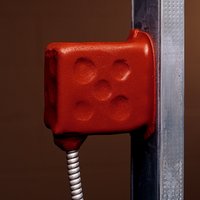Caulks to use:
Silicone could be good for the wire holes. It is flexible, and difficult to paint. In my experience, it's difficult, and often has a short shelf life.
For the box's perimeter, and possibly the wire holes, I would use something flexible and paintable. Acoustic sealant, like Green Glue sealant, or Sashco Big Stretch might be good.
With no access to behind the wall:
Here are ways to seal the wire holes. I don't know which is best. Which is most flexible and crack resistant?
Option 1: Spray foam. Fire block foam could be good. Window foam might be more flexible, but is it safe?
Option 2: Caulk. To get caulk in, tape a tube (like the one from a pen) to the caulk nozzle.
Option 3: duct seal putty
Seal the box's perimeter. If there's plaster around it, it might not be attached well. If so, remove it. Make a big enough gap around the box for caulk. Then, caulk.
With access behind the wall:
Use putty pads. I would still caulk the perimeter and holes first.
Ideally use a box that's better for sealing.
For both ways, use outlet gaskets.
It's also for soundproofing and draft.




